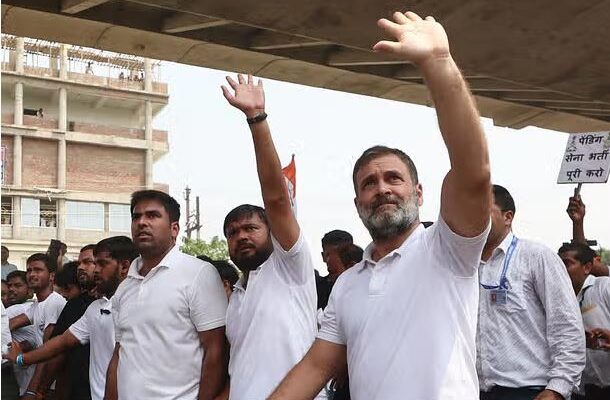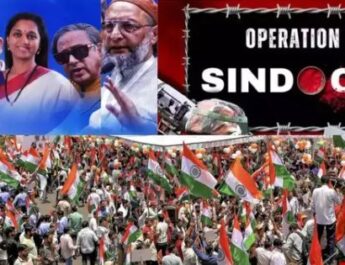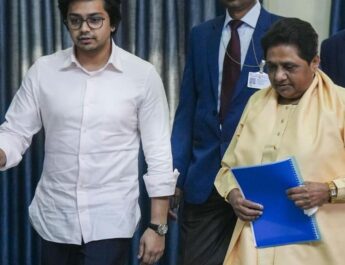Congress, Rahul Gandhi, Gujrat And Bihar
Lack of strategic direction
Confusion among workers and voters
Part-time political engagement
Insufficient communication
Failure to receive appropriate feedback
Prolonged decision-making
Presence of multiple power centers… Political analysts consistently highlight these issues facing Congress. This raises the question: Are these shortcomings fabricated? If these problems are well-known to every worker down to the district level, why are there no solutions? Are Rahul Gandhi and Sonia Gandhi unaware of Congress’s challenges? If they are aware, why do these issues persist? Only Rahul Gandhi can provide answers to these inquiries.
During the Congress Working Committee meeting on Tuesday, Rahul Gandhi remarked that the party has become preoccupied with Dalit, Muslim, and Brahmin issues, while neglecting OBCs. Media reports indicate that he stated, “When we discuss Muslims, we are labeled as Muslim supporters. We should not shy away from such labels; we must continue to address these issues.”
Shifting focus from Gujarat to Bihar, Rahul acknowledged that Congress has made mistakes in Bihar in the past, but assured that this will change. He illustrated this shift with examples, noting that previously, two-thirds of Congress presidents were from upper castes, while only one-third were from Dalit and backward communities. Now, the situation has reversed, with two-thirds of presidents being from Dalit and OBC-EBC backgrounds at both district and state levels. His comments indicate a clear political direction for Congress moving forward. However, it is important to note that Congress has historically refrained from endorsing divisive politics.
The pressing question remains: if the public is expected to embrace caste-based divisive politics, why would backward or Dalit voters choose Congress over Lalu Yadav’s RJD, which has openly supported movements against upper castes? Congress has not played a significant role during these caste conflicts. How can Dalits or backward castes place their trust in Rahul Gandhi, especially when many candidates have identified as Janeudhari Brahmins in various elections?
When Rahul Gandhi was seen visiting temples dressed in saffron and promoting a mild form of Hindutva, I questioned whether the public would not ultimately favor the RSS and BJP when it comes to choosing religious extremism.
The BJP engages in politics that fosters religious division, similar to how parties like the SP and RJD promote caste-based division in Uttar Pradesh and Bihar. This situation leads to two outcomes: first, both the RJD and SP may grow wary of Congress; second, fragmentation within the opposition could bolster the government’s position. In light of this, one must ask whether Congress has any innovative strategies to present to the electorate. If Congress workers cannot articulate why voters should choose their party, how can they expect to connect with the electorate?
Rahul Gandhi should have conducted thorough research prior to making his statements.
Crucially, it seems that Rahul Gandhi’s research team has failed to convey that the upper castes have been instrumental in sustaining Congress in Bihar. While addressing an audience in Bihar, Rahul overlooked the fact that this type of political maneuvering has been prevalent in the state’s politics since before 1990. Karpoori Thakur, a chief minister from the backward caste, and Ram Sunder Das, who hailed from the Dalit community, are notable examples. Additionally, Lalu Yadav, Rabri Devi, and Nitish Kumar, all from the OBC category, have held power in Bihar for the past 35 years.
The political ramifications of confusion surrounding Kanhaiya Kumar’s position are significant.
Following Rahul Gandhi’s remarks regarding the party’s caste dynamics at Sadakat Ashram, the prospects for upper caste leaders within Congress appear bleak. His comments have undermined Kanhaiya Kumar’s political aspirations even before they could take off. Analysts suggest that Kanhaiya’s identity as a Bhumihar may hinder his political emergence, as this community is reportedly not embracing him. Meanwhile, the Congress leadership seems to be aligning itself more with the politics of Dalit and backward communities. In such a situation, workers and local leaders will be confused whether to please the upper castes or adopt the backward Dalits.
Will Kanhaiya, Tejashwi, and Lalu confront each other?
In the realm of politics, it is often observed that individuals prioritize their own interests, with few willing to incur losses. Consequently, during the seat-sharing discussions, it is plausible that Kanhaiya Kumar, Krishna Allavaru, Tejashwi Yadav, Lalu Yadav, and Rahul Gandhi may convene to finalize their agreements.
Lalu Prasad is a significant figure in the political landscape and would be reluctant to see the grand alliance in Bihar weaken. Following the appointment of the new Congress president, Lalu Prasad is expected to take the lead in formulating future strategies regarding this matter. Given his direct communication with Sonia Gandhi and Rahul Gandhi, it is likely that he will engage them in discussions on this topic.
Why is Congress increasingly supporting Kanhaiya?
A pertinent question arises regarding Congress’s growing confidence in Kanhaiya Kumar, especially considering that he was sidelined during the 2024 Lok Sabha elections in Bihar. The Congress party recognizes that Kanhaiya is a vital link to connect with the youth. His assertive articulation of views was evident during the 2019 Lok Sabha elections, where, despite losing significantly, he managed to capture the attention of prominent figures, including Giriraj Singh.
Will Congress succeed in appealing to the upper caste community by replacing Akhilesh Prasad Singh with Kanhaiya Kumar as its representative?
Political analysts and various reports indicate that the Bhumihar community does not yet view Kanhaiya as their leader. Akhilesh Singh’s track record is noteworthy; he managed to secure three seats in the 2024 Lok Sabha elections, thereby establishing a connection between the Bhumihars and the Congress party. The future remains uncertain regarding how effectively Kanhaiya Kumar can engage Bhumihar voters with Congress.
Strengths of Akhilesh Prasad Singh:
- He is the sole leader within the Bihar Congress who personally addresses party workers by name, demonstrating his strong rapport with grassroots members.
- He successfully united the upper caste community, including Bhumihars, with the Congress party.
- Under his leadership, Sadakat Ashram underwent significant transformation, showcasing his resourcefulness and independence from reliance on Delhi.
- In the presence of astute political figures like Lalu Yadav, Akhilesh Singh stands out as the only leader in Bihar Congress capable of negotiating effectively for seat adjustments.
- Through his tours and padayatras, Akhilesh Singh has revitalized enthusiasm among party workers in what was previously a stagnant organization.
Congress on an independent path!
Akhilesh Prasad Singh had staked a claim for 70 seats; however, the RJD appeared unwilling to concede that many. With Akhilesh Singh’s exit, it has become evident that Congress is no longer inclined to operate under RJD’s influence.
Similar to its approach in Delhi, where Congress undermined the Aam Aadmi Party by refusing to form an alliance, it seems poised to adopt a similar strategy in Bihar. Following the appointment of the new state Congress president, the RJD may find itself at a disadvantage. Should seat-sharing negotiations not align with Congress’s terms, the party may declare its intention to contest the elections independently in Bihar.
Who is Rajesh Kumar?
Rajesh Kumar serves as the MLA for the Kutumba assembly constituency in Aurangabad district, Bihar. He successfully secured victory in this seat during the 2015 and 2020 elections.
The Kutumba seat was established following the delimitation process in 2008 and is designated as a reserved seat for Scheduled Castes. Rajesh Kumar’s father, Dilkeshwar Ram, who hailed from Obra in Aurangabad, served as a Congress MLA in 1980 and 1985, representing the Dev seat of Aurangabad. Dilkeshwar Ram also held the positions of Animal Husbandry-Fisheries Minister and Health Minister in the Congress government.
Reasons for Selecting Rajesh Kumar
- He represents a Dalit face in contemporary Congress politics, although he has not gained recognition as a Dalit leader at the state level.
- The current president is perceived as weak and merely a figurehead for the Bihar Congress leadership.
- There is insufficient strength in the objections raised against appointing Kanhaiya as a prominent figure.
Congress’ Strategic Approach
Political analysts suggest that Congress is attempting to forge connections with Bhumihar, Muslim, and Dalit communities, reminiscent of the coalition during the era of Shri Krishna Babu. At first glance, this initiative appears to be a positive step for Congress as it seeks to emerge from the influence of Lalu Prasad Yadav and strengthen its organizational structure. This should indeed be the focus of their strategy. Congress must clearly decide whether it aims to build its organization or simply seeks a share of power. After years, Congress entered Delhi with a clear vision, even though it did not secure victory, sending a strong message to its members that there is no ambiguity in their objectives. The question arises whether Congress is signaling a need to distance itself from Lalu Yadav’s influence in Bihar or if it is merely engaging in pressure tactics to secure favorable seats from Lalu Yadav’s RJD. In 2022, Akhilesh Prasad Singh assumed the presidency of Bihar Congress. It is noteworthy that in 2019, there was significant contention between Congress and RJD over seat allocation. Political insiders claim that Akhilesh Prasad Singh played a crucial role in facilitating an agreement on seat sharing between Congress and RJD.
For Congress to move forward, it must first acknowledge its voter base and advocate for their interests. Traditionally, the party’s support comes from Muslims, Dalits, certain upper castes, and segments of the OBC community. However, Congress often positions itself as a party for all, which leads to the neglect of its core supporters. Furthermore, when in power—whether at the state or national level—Congress tends to overlook its foundational voter base in terms of representation and policy-making.
Congress can draw valuable lessons from the BJP regarding how to advance its agenda while remaining largely unaffected by criticism. This approach has allowed the BJP to maintain a loyal core voter base, as the party consistently delivers for its supporters when in power, resulting in unwavering loyalty. In contrast, the Muslim and Dalit voters who traditionally supported Congress have become disillusioned, leading to a series of disappointing electoral outcomes. For example, in the 2019 General Election, Congress managed to win only one seat, as a significant portion of its core voters shifted their allegiance to the Vanchit Bahujan Aghadi, led by Prakash Ambedkar and Owaisi. This trend was similarly observed in the 2020 Bihar Assembly Election.
In today’s landscape, shaped by social media and heightened individual aspirations regarding identity, it is crucial for Congress to recognize these changes. If the party wishes to endure, it must adopt strategies from its rival that effectively engage and reassure its core voter base.




